This website contains affiliate links. Some products are gifted by the brand to test. As an Amazon Associate, I earn from qualifying purchases. The content on this website was created with the help of AI.
Welcome to our guide on how to give a cat a pill without stress! Administering medication to your feline friend can be a challenging task, but with the right approach, it can be done easily and efficiently. In this section, we will provide you with simple steps and valuable tips to ensure a successful cat pill administration experience, promoting the health and well-being of your beloved pet.
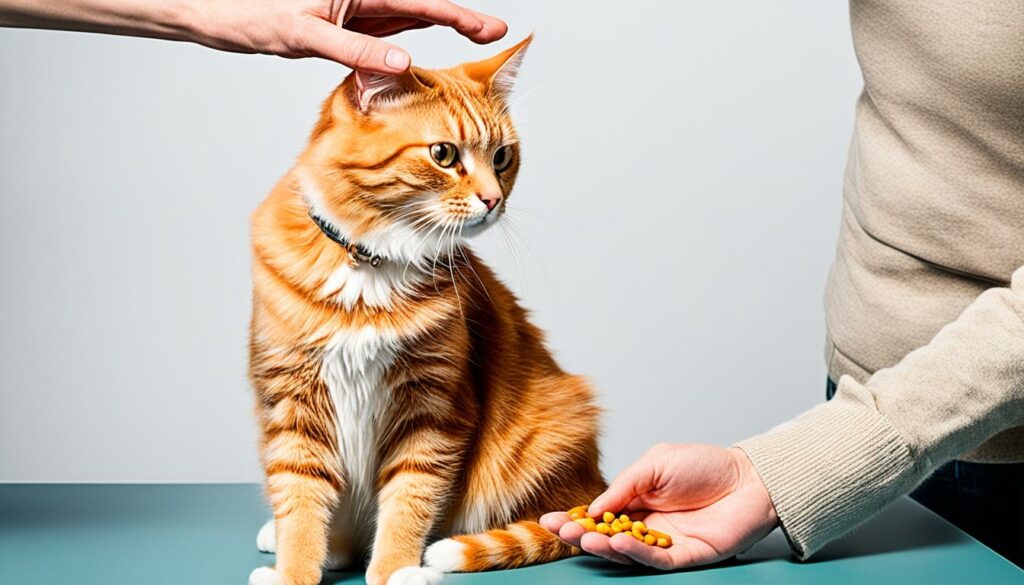
Key Takeaways:
- Follow these steps to give your cat a pill stress-free
- Preparation is key for successful administration
- Practice the techniques before attempting the real medication
- Approach your cat confidently, using gentle yet firm techniques
- Consult your veterinarian for tailored advice
Understanding the Importance of Medicating Your Cat
Before we delve into the steps of feline pill administration, it’s crucial to understand the importance of medicating your cat when necessary. Your cat’s health and well-being depend on receiving the proper medication.
Administering medication to your cat can help alleviate symptoms, treat underlying conditions, and improve their overall quality of life. Whether it’s for a short-term ailment or a long-term health issue, timely medication plays a vital role in your cat’s recovery and management of their condition.
Regular medication can also prevent the worsening of symptoms, complications, and future health problems. It’s essential to follow your veterinarian’s instructions carefully and administer the prescribed medication as directed.
By medicating your cat when needed, you’re actively investing in their well-being, ensuring they have the best chance at a happy and healthy life.
Now, let’s explore some essential cat health care tips to help you navigate the world of feline pill administration effectively.
Preparing for Pill Administration
It’s crucial to be prepared before administering a pill to your cat. By taking the necessary steps and creating a supportive environment, you can ensure a successful pill-giving experience for both you and your furry friend.
Here are some techniques and tricks for effective cat medication administration:
Gathering Supplies
Struggle no more with medicating your feline friend! Discover the stress-free solution with Greenies Feline Pill Pockets. These natural, soft chicken-flavored treats disguise pills, making medication time a breeze. Ideal for cat owners seeking a hassle-free approach to ensure their pets get the necessary treatment without the fuss.
To smoothly administer a pill to your cat, it’s important to have all the necessary supplies readily available. This includes:
- Pill dispenser or pill popper device
- Pill pockets or treats to hide the pill
- Gloves (if necessary)
- A towel or blanket to help restrain your cat if needed
Make sure to gather these supplies in advance so that you’re fully equipped when it’s time to administer the medication.
Creating a Calming Environment
Cats can be sensitive to their surroundings, so it’s important to create a calming environment before giving them a pill. Here’s how:
- Choose a quiet, comfortable space where your cat feels secure.
- Ensure there are no distractions or loud noises that may cause anxiety.
- Dim the lights or provide soft lighting to promote relaxation.
Creating a peaceful atmosphere can help reduce your cat’s stress and make the pill-giving process smoother.
| Pill Giving Techniques for Cats | Description |
|---|---|
| Using a Pill Dispenser | A pill dispenser is a helpful tool that allows you to place the pill directly in your cat’s mouth without using your fingers. It ensures accurate delivery and reduces the risk of getting bitten. |
| Using Pill Pockets or Treats | Pill pockets or treats are designed to hide the pill, making it easier for your cat to swallow. These tasty treats can mask the medication’s taste and texture, increasing the chances of successful administration. |
| Gentle Restraint | If necessary, gently restrain your cat by wrapping them in a towel or blanket that allows you to safely hold them while administering the pill. This can provide stability and prevent your cat from escaping or resisting the medication. |
Remember, every cat is unique, and what works for one may not work for another. It’s essential to observe your cat’s behavior and adjust your approach accordingly. With patience, practice, and a well-prepared environment, you can confidently administer pills to your cat and ensure their health and well-being.
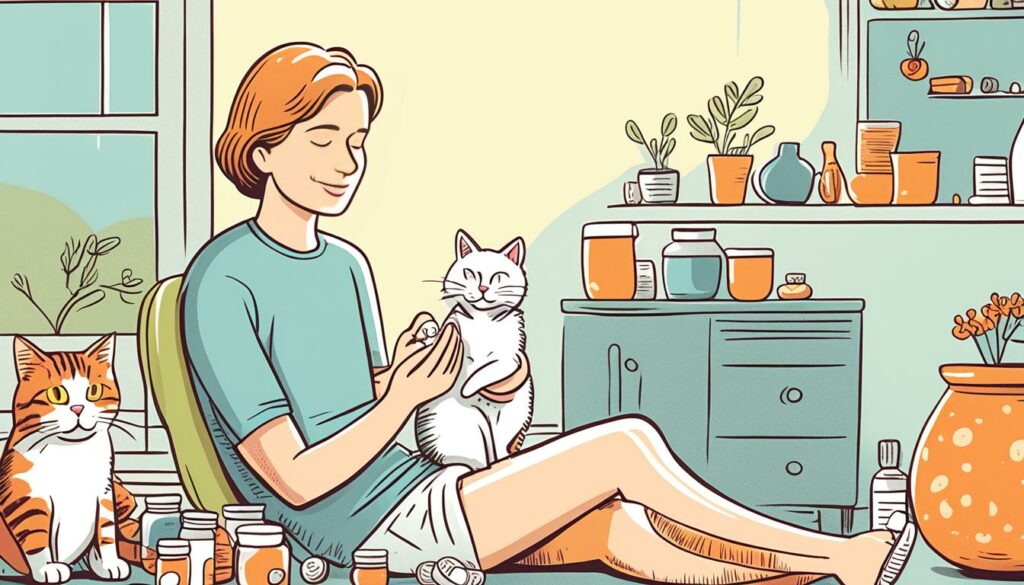
Choosing the Right Technique
Different cats may respond better to specific pill administration techniques. Finding the right method for your feline friend is crucial to ensure effective and stress-free cat pill administration.
Methods for Cat Pill Administration
Here are some popular techniques that you can consider:
- Pill Pocket: This method involves hiding the pill inside a treat or specially designed pill pocket. Many cats find this method appealing and consume the medication without resistance.
- Pill Crusher and Mixing: If your cat refuses to take pills, you can crush the medication into a powder and mix it with a small amount of wet food or treat. Ensure your cat consumes the entire mixture to ensure proper dosing.
- Manual Administration: For cats who are comfortable with handling, you can manually administer the pill by gently opening their mouth and placing the pill at the back of their tongue. Always remember to follow up with a small amount of water to help them swallow the pill.
Ultimately, the best technique depends on your cat’s preferences and individual needs. It may take some trial and error to find the method that works best for your furry companion.
Here’s a visual representation of the different cat pill administration techniques:
| Technique | Advantages | Disadvantages |
|---|---|---|
| Pill Pocket | – Easily conceals medication – Cats find it appealing | – May not work for cats with strong taste preferences |
| Pill Crusher and Mixing | – Allows flexibility in administering medication – Can be mixed with your cat’s favorite food | – Requires accurate dosing and measuring – Can be time-consuming |
| Manual Administration | – Direct control over medication delivery – Quick and effective | – May cause discomfort for cats not used to handling – Risk of accidentally injuring your cat |
Remember to consult with your veterinarian to determine the most suitable technique for your cat’s specific medication needs. They can provide guidance based on your cat’s health condition and individual preferences. With patience and perseverance, you’ll find the right cat pill administration technique that works best for you and your beloved feline.
Practice Makes Perfect
Like any new skill, giving a cat a pill requires practice. Fortunately, there are techniques you can employ to hone your pill-giving abilities and boost your confidence before attempting to administer medication to your feline companion.
Tips for Practicing Cat Medication Techniques
- Start by using a practice pill or a small treat that mimics a pill in size and shape. This will allow you to practice handling and maneuvering the “pill” without the pressure of giving actual medication.
- Practice different pill-giving techniques, such as wrapping the pill in a treat or using a pill dispenser designed specifically for cats. Experiment with various methods to determine which one works best for you and your cat.
- Simulate real-life scenarios by practicing in different environments and with distractions. This will help you prepare for situations where your cat may be less cooperative or easily distracted.
- Involve a partner or family member in the practice sessions. Not only will this provide an extra set of hands, but it will also allow you to simulate scenarios where your cat may need to be restrained.
Remember, practice is key to mastering the art of cat pill administration. By dedicating time to practice these techniques, you’ll feel more confident and comfortable when it comes time to give your cat their actual medication.
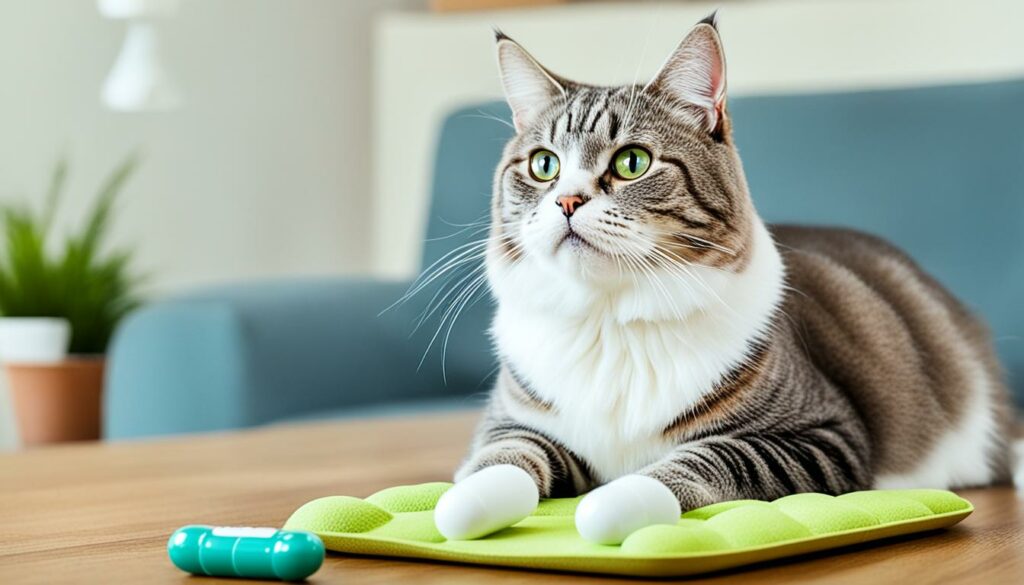
Why Practice Makes a Difference
“Practice makes perfect” is a saying that holds true for many aspects of life, including giving a cat a pill. Practicing the pill-giving techniques not only allows you to become more proficient, but it also helps familiarize your cat with the process. The more you practice, the more comfortable both you and your cat will become.”
By investing time and effort into practicing the art of cat pill administration, you’ll be well-prepared to handle any challenges that may arise. Practice not only improves your skills but also ensures a stress-free and successful medication administration experience for both you and your feline friend.
Approaching Your Cat with Confidence
When it comes to giving your cat medication, it’s important to approach the task with confidence. Cats can be sensitive creatures and may resist taking pills, but with the right techniques and mindset, you can successfully administer their medication. Here are some cat medication tips to help you dose a cat with pills effectively and with minimal stress.
Create a Bond of Trust
Building a bond of trust with your cat is crucial before attempting to give them medication. Spend quality time with your furry friend, offering treats and gentle affection. This will help your cat feel more comfortable and trusting of your touch.
Choose the Right Time and Place
Select a quiet and calm environment for pill administration. Remove distractions, such as loud noises or other pets, that could cause stress for both you and your cat. Avoid attempting to give medication when your cat is agitated or anxious.
Use Gentle Yet Firm Restraint
Proper restraint is essential to ensure your cat’s safety and prevent injuries. Place one hand firmly but gently on the back of your cat’s neck, behind their ears, where the scruff is located. This will help immobilize their head and minimize movements.
Practicing the “Pill Pocket” Technique
The “pill pocket” technique is a popular and effective method for giving pills to cats. It involves concealing the pill inside a small treat or soft food. Here’s how to do it:
- Choose a soft treat or food that your cat loves and is easily moldable.
- Divide the treat into two halves or quarters, depending on the size of the pill.
- Place the pill in the center of one of the halves or quarters.
- Cover the pill with the remaining portion of the treat, ensuring it is completely sealed.
- Offer the “pill pocket” treat to your cat, allowing them to eat it in one bite.
This technique disguises the pill, making it easier for your cat to swallow without realizing it. However, it’s important to ensure that your cat has fully swallowed the pill and not just eaten around it.
Seek Professional Advice
If you’re still struggling to administer medication to your cat, don’t hesitate to seek advice from your veterinarian. They can provide additional cat medication tips and techniques tailored to your cat’s specific needs, ensuring their health and well-being.
Approaching your cat with confidence and using gentle yet firm techniques can make the pill administration process smoother and less stressful for both you and your feline friend. Remember, practice and patience are key. With time and persistence, you’ll become an expert at dosing a cat with pills.
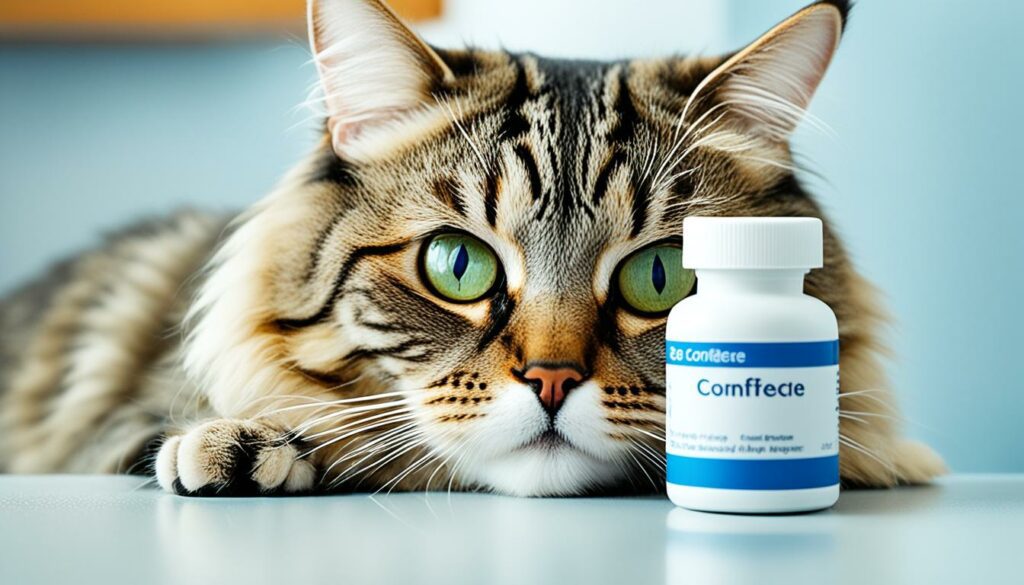
Understanding Your Cat’s Behavior
Successfully administering medication to your cat requires a thorough understanding of their behavior. By being aware of common feline behaviors, you can anticipate any challenges that may arise during the pill administration process. This knowledge will enable you to approach the task with confidence and ensure the well-being of your furry friend.
Here are some key feline behaviors to consider:
- Resistance: Cats are known for their independent nature, and many may resist taking medication. They may hide, scratch, or become vocal when approached with a pill. Understanding this behavior will help you develop appropriate strategies for successful administration.
- Oral Sensitivity: Some cats have a heightened sensitivity to touch and may be particularly averse to having their mouths handled. This can make opening their mouth and placing a pill inside challenging. Being aware of this behavior will help you approach your cat with gentleness and patience.
- Escape Tactics: Cats are agile creatures and may attempt to escape when they sense medication. They may use their speed and agility to evade your attempts. Recognizing this behavior allows you to create a secure environment during administration.
- Hiding: When faced with medication, some cats may retreat to hiding places where they feel safe and secure. Discovering their hiding spots will allow you to approach them calmly and minimize stress during pill administration.
- Food Aversion: Cats may be suspicious of unfamiliar smells or tastes, which can make it difficult to hide medication within food. Understanding this behavior will help you explore alternative administration methods to ensure your cat’s compliance.
By recognizing and understanding these behaviors, you can tailor your approach to pill administration and minimize stress for both you and your cat.
Feline Behavior Expert Insights:
“Cats are unique individuals, and each one may respond differently to medication administration. Understanding their behavior is key to implementing successful techniques. Take the time to observe your cat’s reactions and adjust your approach accordingly.”
– Dr. Emily Johnson, Feline Behavior Specialist
Taking note of your cat’s individual behavior and preferences will allow you to develop a personalized approach to medication administration. With patience, practice, and a deep understanding of your cat, you can ensure their health and well-being.
| Feline Behaviors | Strategies for Pill Administration |
|---|---|
| Resistance | Use gentle restraint techniques and offer rewards for cooperation. |
| Oral Sensitivity | Practice desensitization exercises to acclimate your cat to touch around their mouth. |
| Escape Tactics | Create a secure and calm environment to minimize the chances of escape. |
| Hiding | Approach your cat calmly and offer reassurance in their hiding spots. |
| Food Aversion | Explore alternative medication administration methods like pill pockets or compounding. |
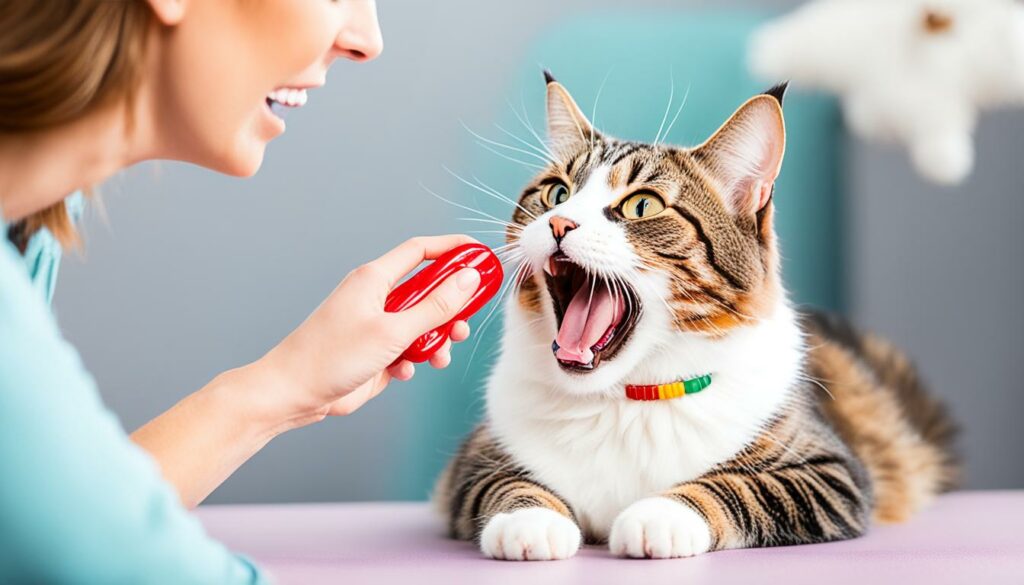
Administering the Pill
Now that you’re prepared and ready to give your cat a pill, let’s walk you through the step-by-step process. With a little patience and practice, you’ll become a pro at cat pill administration.
Holding Your Cat Correctly
Start by gently restraining your cat to ensure both of you remain safe during the process. Use one hand to hold your cat’s front paw while using the other hand to stabilize their body. This technique helps to prevent scratching or biting while you administer the pill.
Opening Your Cat’s Mouth
Next, you’ll need to open your cat’s mouth to create a pathway for the pill. With your free hand, gently hold your cat’s upper jaw near the cheeks, applying light pressure to encourage their mouth to open. Be careful not to squeeze too tightly or cause discomfort.
Administering the Pill
Place the pill as far back in your cat’s mouth as possible, preferably over the base of the tongue. Use your index finger or a specialized pill dispenser to deliver the pill quickly and directly to the desired location. Ensure the pill is not too large or awkwardly shaped, as this may make it difficult for your cat to swallow.
Helping Your Cat Swallow
Once the pill is in place, gently close your cat’s mouth and hold it closed while tilting their head slightly upwards. This will naturally encourage swallowing. Maintain a firm grip on your cat’s muzzle to prevent them from spitting out the pill.
Alternatively, you can gently stroke your cat’s throat or blow on their nose to trigger the swallowing reflex. Some cats may prefer a little water to help wash down the pill. If this is the case, use a syringe or dropper to administer a small amount of water, ensuring that the pill has been swallowed.
“Remember to stay calm and patient throughout the process. Cats can sense your energy, so a relaxed approach will help ease any tension.”
Ensuring Success
To ensure your cat has successfully swallowed the pill, wait for a few moments to observe any signs of rejection or regurgitation. If you notice your cat spitting out the pill, don’t panic. Simply repeat the process, making sure to hold your cat correctly and administer the pill gently.
Remember to reward your cat with a treat or praise immediately after they have successfully swallowed the pill. Positive reinforcement will create a pleasant association and make future administrations easier.
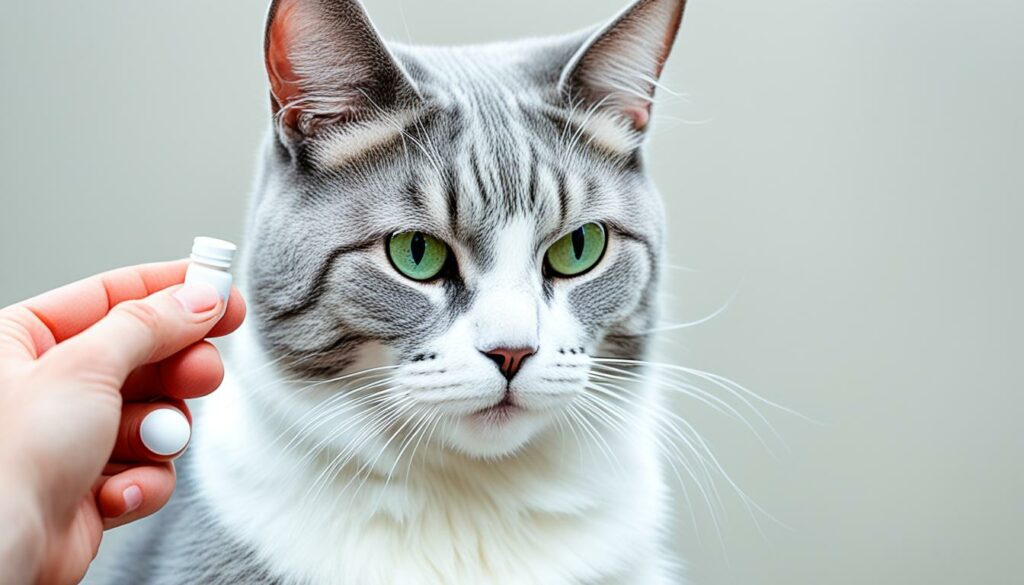
| Pill Administration Tips | Benefits |
|---|---|
| Use a pill dispenser | Provides precise and controlled pill delivery |
| Try a pill pocket treat | Masks the pill’s taste and odor, making it more appealing to your cat |
| Mix the pill with wet food | Blends the pill with your cat’s regular meal, making it less noticeable |
| Use a specialized veterinary compounding service | Creates custom-flavored medications tailored to your cat’s preferences |
Troubleshooting Tips
Sometimes, administering pills to cats can be challenging, especially when they resist. But don’t worry, we’ve got you covered with some helpful troubleshooting tips to ensure your cat receives the necessary medication.
1. Hide the Pills in Treats
One effective technique is to hide the pill inside a treat or a soft food item that your cat loves. This can help mask the taste and texture of the pill, making it easier for your cat to swallow.
2. Use a Pill Dispenser
A pill dispenser is a handy tool designed to hold the pill securely and safely administer it to your cat’s mouth. It eliminates the need for physically opening your cat’s mouth, reducing the chance of accidental bites or scratches.
3. Crushing the Pill
If your cat refuses to swallow pills, you can crush them into a fine powder and mix them with a small amount of wet food. Be sure to check with your veterinarian if the medication is safe to crush before attempting this method.
4. Seek Professional Assistance
If all else fails and your cat continues to resist pill administration, consult your veterinarian for further guidance. They may be able to provide alternative medication options or suggest other techniques that suit your cat’s specific needs.
Remember, patience and persistence are key when administering medication to your cat. It may take some time to find the best approach that works for both you and your furry friend.
| Troubleshooting Tips | Effectiveness |
|---|---|
| Hide the Pills in Treats |     |
| Use a Pill Dispenser |    |
| Crushing the Pill |   |
| Seek Professional Assistance |    |
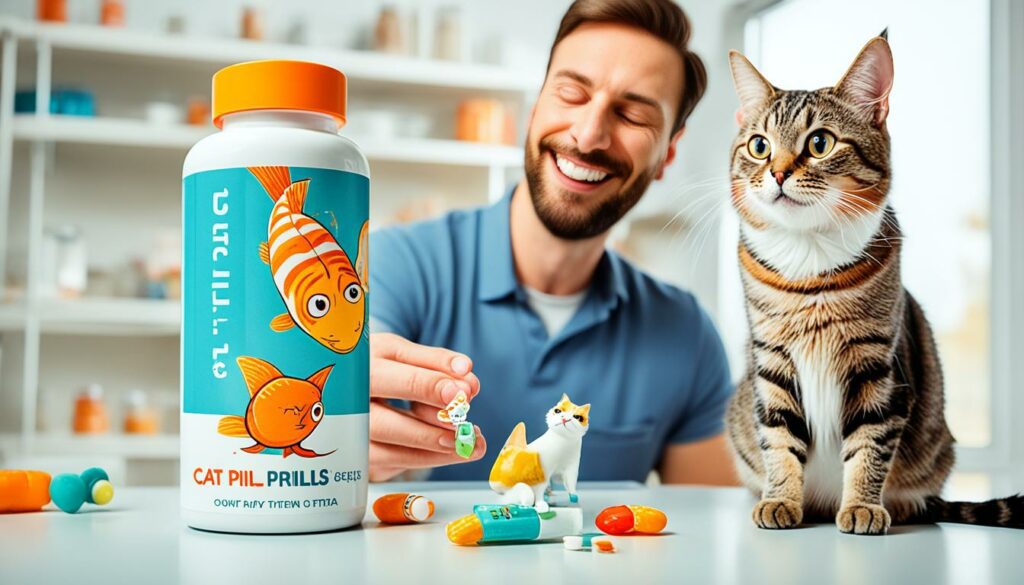
Pill Alternatives for Difficult Cats
If your cat consistently refuses to take pills, don’t worry! There are alternative options available to ensure your cat gets the medication they need. Below, we’ll explore alternative medication methods and techniques you can try for the wellbeing of your feline friend.
1. Liquid Medication
Sometimes, giving your cat liquid medication can be easier than pills. Your veterinarian may be able to prescribe the medication in a liquid form that can be easily administered using a syringe. Simply place the syringe at the side of your cat’s mouth and slowly dispense the medication, allowing them to swallow it naturally. It’s important to follow your vet’s instructions and dosages accurately.
2. Treatments and Chews
Another option is to use medication treatments or chews that are formulated to be more palatable for cats. These products often come in tasty flavors that mask the medication’s taste, making it easier for your cat to consume. Just be sure to choose products that are specifically designed for cats and follow the recommended dosage.
3. Transdermal Medications
In certain cases, your veterinarian may recommend transdermal medications. Transdermal medications are applied to the skin and absorbed by your cat’s body. This method eliminates the need for oral administration and can be particularly helpful for cats who are difficult to medicate. Your vet will provide you with specific instructions on how to apply the medication and where on your cat’s body to administer it.
4. Compounded Medication
If your cat has an aversion to a certain medication, your vet may be able to have it compounded. Compounded medications are specially tailored to your cat’s preferences, such as being made more palatable or in a different form. This individualized approach can make it easier to administer the medication and ensure your cat receives the necessary treatment.
5. Injectable Medication
In some cases, injectable medications may be a viable alternative. Your veterinarian can administer the medication via injection, ensuring your cat receives the necessary treatment without the need for oral medication. However, this method usually requires regular visits to the vet’s office.
Remember, it’s important to consult with your veterinarian before trying any of these alternative medication methods. They will be able to assess your cat’s specific needs and provide guidance on the most suitable option.
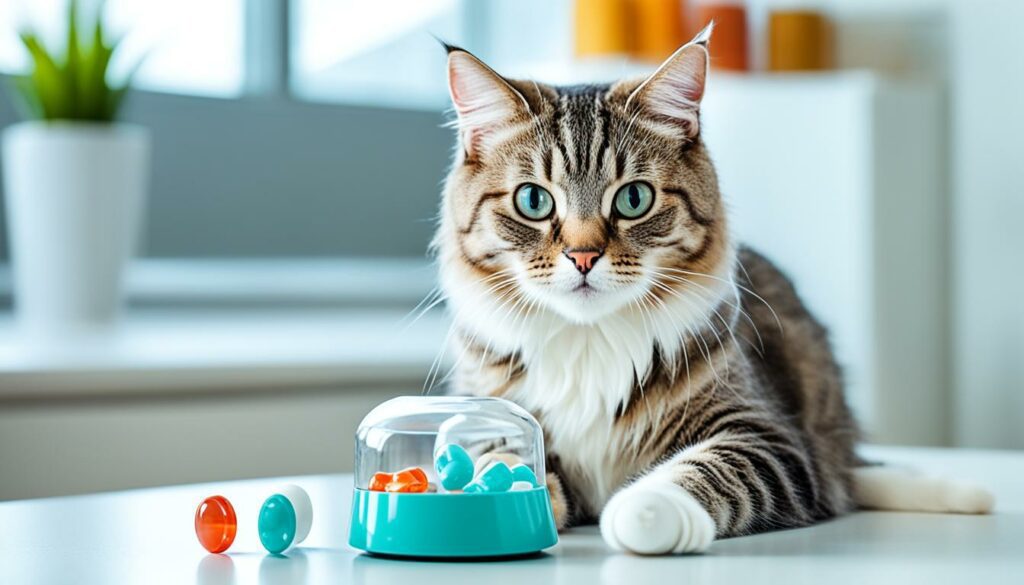
By exploring these pill alternatives, you can find a method that works best for your cat’s individual needs. Remember to be patient and gentle with your furry friend, and always prioritize their comfort and wellbeing.
Staying Consistent with Medication
Consistency is crucial when it comes to feline pill administration. By establishing a routine, you can ensure that your cat receives their medication as prescribed. Here are some strategies to help you stay consistent:
1. Set a Schedule
Try to administer the medication at the same time every day. This will help your cat get used to the routine and make it easier for you to remember.
2. Use Reminders
Set up reminders on your phone or use a calendar to keep track of medication times. This can help you stay organized and ensure that you don’t miss a dose.
3. Create a Peaceful Environment
Choose a quiet area where you can administer the medication without distractions. Make sure the space is comfortable and calming for your cat.
4. Involve Treats or Rewards
Offering treats or rewards can help make the pill administration experience more positive for your cat. You can give a treat before and after giving the medication to create a positive association.
5. Remain Calm and Patient
Cats can pick up on your emotions, so it’s important to stay calm and patient during the process. Speak softly and reassure your cat throughout the pill administration.
Remember, each cat is unique, and it may take time to find a routine that works best for both you and your feline friend. Stay consistent, and reach out to your veterinarian if you have any concerns or need further guidance.
Rewarding Your Cat
After successfully administering medication to your cat, it’s important to reward them and reinforce positive behavior. By creating a pleasant experience around pill administration, you can reduce stress and make future administrations easier. Here are some cat health care tips on how to reward your furry friend:
- Treats: Use delicious treats as a reward for your cat after pill administration. Choose treats that your cat loves and offer them immediately after giving the pill. This positive association will make your cat more cooperative during future pill administrations.
- Praise and Affection: Cats respond well to verbal praise and physical affection. After giving the pill, gently stroke and praise your cat with soothing words. Show them love and let them know they’ve done a great job.
- Playtime: Engaging in interactive playtime sessions with your cat can be a great reward. Play with their favorite toys and spend quality time together. This will distract them from the pill administration and create positive associations with the overall experience.
Remember, reward your cat immediately after pill administration to reinforce the connection between the reward and the medication process. By rewarding your cat, you can make the entire experience less stressful and build a stronger bond with your furry friend.
Rewarding Your Cat Methods
| Rewarding Method | Description |
|---|---|
| Treats | Use delicious treats to reward your cat after pill administration. |
| Praise and Affection | Offer verbal praise and physical affection to reinforce positive behavior. |
| Playtime | Engage in interactive play sessions to distract from the pill experience. |
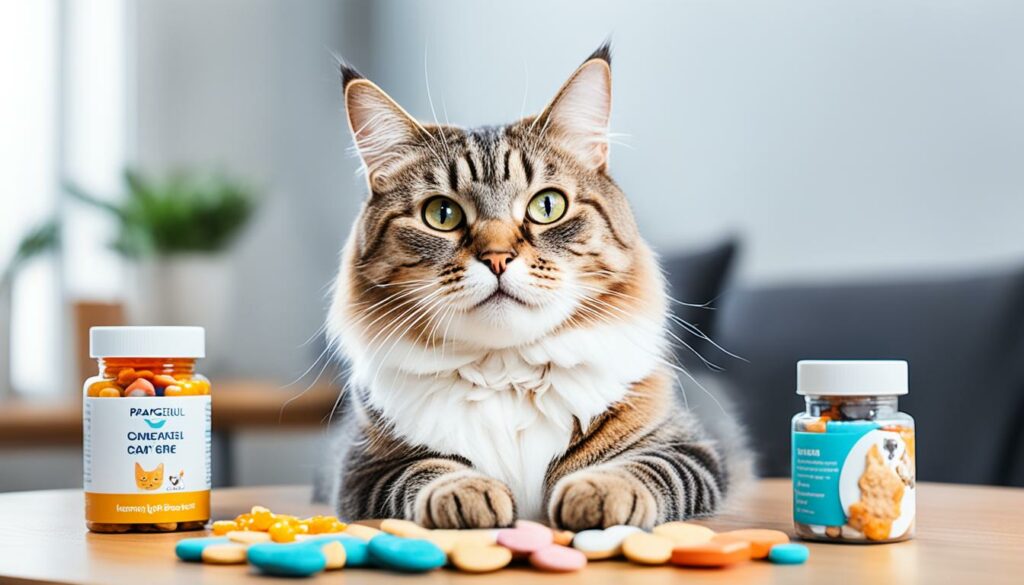
Consulting Your Veterinarian
When it comes to the health and well-being of your furry friend, consulting with your veterinarian is essential. Your veterinarian has the expertise and knowledge to provide personalized advice and guidance on your cat’s specific medication needs.
During your visit, be sure to discuss any concerns or questions you may have regarding your cat’s medication. Your veterinarian can offer valuable insights, dosage recommendations, and potential side effects to watch out for. They can also provide instructions on the best practices for administering medication to your cat.
Remember, each cat is unique, and what works for one may not work for another. The guidance of your veterinarian ensures that your cat receives the appropriate care and treatment.
“Your veterinarian is your partner in caring for your cat’s health. Don’t hesitate to reach out for professional advice and support.”
In addition to providing medication-related information, your veterinarian can also offer invaluable tips on maintaining your cat’s overall health. They can advise you on proper nutrition, exercise, and preventive measures to keep your cat in peak condition.
Regular check-ups with your veterinarian are crucial to monitor your cat’s health, discuss any changes or concerns, and ensure that your cat’s medication is still appropriate for their needs.
Remember, your veterinarian’s expertise and knowledge are invaluable resources that can help you navigate the complexities of feline health care.
| Benefits of Consulting Your Veterinarian | Why It Matters |
|---|---|
| Personalized advice and guidance | Your veterinarian can provide specific recommendations tailored to your cat’s needs. |
| Expertise and knowledge | Your veterinarian can offer insights on medication dosage, potential side effects, and proper administration techniques. |
| Overall health care | Your veterinarian can provide valuable tips on nutrition, exercise, and preventive measures to keep your cat healthy. |
| Monitoring and check-ups | Regular visits allow for monitoring of your cat’s health and ensure medication effectiveness. |
Consulting your veterinarian is a crucial step in providing the best care for your cat. Their expertise and guidance will help ensure that your cat’s medication needs are met and that they live a happy, healthy life.

Conclusion
By following the easy steps and implementing the tips and techniques provided in this guide, you’ll be well-equipped to give your cat a pill stress-free. Remember, patience and practice play a crucial role in mastering the art of feline pill administration, ensuring your cat’s health and well-being.
Administering medication to your cat may seem challenging at first, but with the right approach and understanding, it becomes a manageable task. By preparing for pill administration, choosing the right technique, and approaching your cat with confidence, you can successfully give your feline friend their medication without stress.
Understanding your cat’s behavior and staying consistent with medication are key factors in the administration process. Additionally, rewarding your cat after pill administration helps create positive associations and reduces any associated stress. Remember, your veterinarian is always there to provide tailored advice and guidance specific to your cat’s needs.
FAQ
How can I give my cat a pill without stress?
Giving a pill to a cat can be challenging, but with the right approach, it can be stress-free. By following our easy steps and tips, you can successfully administer medication to your feline friend with minimal stress or resistance.
Why is it important to medicate my cat?
Medicating your cat is crucial for their health and well-being. It helps treat and prevent various illnesses and conditions. By following proper feline medication practices, you can ensure your cat’s overall health and longevity.
How can I prepare for giving my cat a pill?
Before giving your cat a pill, it’s important to be prepared. Gather all the necessary supplies, create a calm environment, and familiarize yourself with the techniques. Being prepared will help make the pill administration process easier for both you and your cat.
What are the different techniques for administering pills to cats?
There are several techniques you can try to administer pills to cats. Some options include hiding the pill in treats or food, using a pill dispenser tool, or manually opening your cat’s mouth and placing the pill. The right technique depends on your cat’s preferences and comfort level.
How can I practice giving my cat a pill?
Practice is key to successful pill administration. Before attempting it for real, practice the techniques with a mock pill or treat. This allows you to become familiar with the process and increases your confidence when giving your cat their actual medication.
How can I approach my cat with confidence during pill administration?
Approaching your cat with confidence is important when giving them a pill. Use gentle yet firm techniques, ensure a calm environment, and speak gently to your cat. Building trust and maintaining a calm demeanor will help your cat stay relaxed during the medication process.
What should I do if my cat resists pill administration?
If your cat resists pill administration, try troubleshooting tips such as using pill pockets or mixing crushed pills with their food. If these methods don’t work, consult your veterinarian for alternative medication options or techniques.
How do I administer a pill to my cat step-by-step?
Administering a pill to your cat involves several steps. First, hold your cat correctly, then use one hand to open their mouth and the other to place the pill at the back of their throat. Gently close their mouth and encourage them to swallow. Make sure to safely dispose of any packaging or unused medication.
What are some alternative medication methods for difficult cats?
If your cat consistently refuses to take pills, alternative medication methods can be explored. These may include liquid medication, topical treatments, or injections. Consult your veterinarian to discuss which method is most suitable for your cat’s needs.
How can I establish a consistent medication routine for my cat?
Consistency is key when it comes to medicating your cat. Establish a regular medication schedule, set reminders, and create a routine that works for both you and your cat. This will help ensure your cat receives their medication as prescribed.
How can I reward my cat after pill administration?
Rewarding your cat after pill administration can create positive associations. Offer treats, praise, or playtime as a reward for their cooperation. This encourages good behavior and reduces stress associated with the pill-taking experience.
Why is it important to consult my veterinarian regarding medication?
Consulting your veterinarian is essential for your cat’s specific medication needs. They can provide tailored advice, recommend the appropriate medication, dosage, and offer guidance on the best administration techniques for your cat’s unique circumstances.
What should I remember after following these steps?
After following the easy steps and implementing the tips and techniques provided, you’ll be well-equipped to give your cat a pill stress-free. Remember, patience and practice play a crucial role in mastering the art of feline pill administration, ensuring your cat’s health and well-being.
This website contains affiliate links. Some products are gifted by the brand to test. As an Amazon Associate, I earn from qualifying purchases. The content on this website was created with the help of AI.









